Their “secret” is the
unexpected use of unique spices
The spices “battle” took place over 2 days and brought a
nail biting finish to the contest. Finally the best use of new spices was
honored in the closing ceremony, held on the evening on October 28th
2015.
It is very sad that many other spices stay hidden as they
deserved to be honored, also.
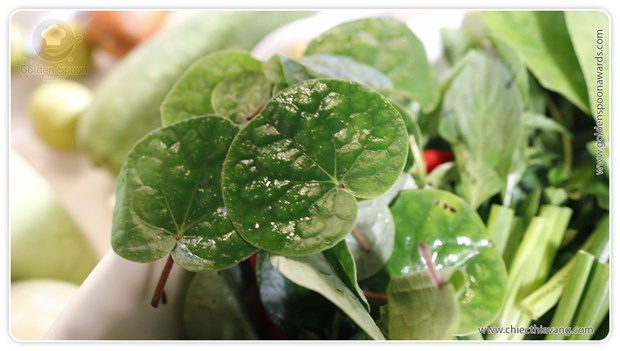
Lá dổi
“Lá dổi” and “lang rây” are significant spices from the Northwest area. “Lá đầu”
looks like Japanese centella, has a sour taste and the aroma of Salsepareille.
“Lá sau” leaves are similar in
appearance to Lychee but are bigger and thinner. When chewed the leaves release
a gentle aroma of coriander leaf whilst tasting a little sweet. Mrs Suong Thi
Bui is very interested in these wild leaves. Knowing that normally they are
used to make specific dishes with good flavor like grills, steamed dishes and soup
Also in the Northern highlands, white and black Canarium
odontophyllum, a member of the Burseraceae
family, is also being brought to the festival. The skin of the
white variety retains its acrid taste. Tasting the black Canarium odontophyllum
one finds a taste similar to chestnut. The head chef from team No.40 (Binh Quoi
II Tourist area), Cuong Kim Nguyen, used them to make salad and steamed fish
dishes with satisfactory results.
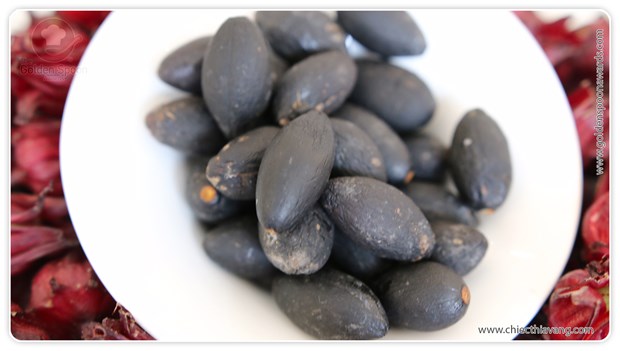
Black Canarium odontophyllum
In the highlands area, bitter and sweet flavors from the “Đọt mây”
family plus bitter and sweet tomatoes are also sure to make an appearance in
the festival. “Đọt mây” is grilled until its skin is blackened. Chef Nguyen Duc
Hoang from team No.78 (Anh Duong hotel, Kon Tom) peels off the skin and used
the flesh inside to make an appetizer with duck breast and an aromatic sauce
made from “Bông é rừng”. Bitter “Đọt mây” retains its taste long in your
mouth and then leaves an unexpected sweetness. In particular, the sweet “Đọt mây” taste is a subtle but powerful one
that is long lasting. Tied together with green scallions they form the perfect
combination. As they say in Vietnam as beautiful as a Peacock and a Phoenix.
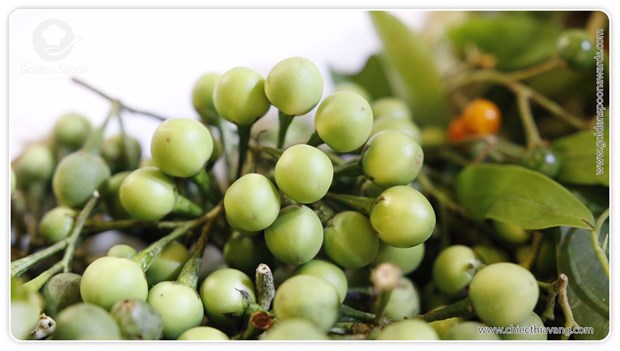
Button tomato
Many similar stories also surround the bitter and sweet
tomatoes (button tomatoes) in Chu Ma Ray village, Sa Thay town, Kon Tum
province; just as with other spices mentioned above. This time, they are served
together with a stew made of local pork. The tomatoes are still fresh and green
and remain a strongly aromatic. “Heo lông
ba chấu” is a specific type of pig similar to wild pig. The belly fat is
about half of the common pig, but it is very crispy and extremely delicious.
Chef Hoang said that the Bana people, of Gia Rai raise the pig by releasing
them to roam run free in the jungle. This enables crossbreeding with wild pigs,
with the resultant offspring called F1 pigs. These make for very good eating.
In the jungle of Eastern area lies Bombo village, where our
soldiers received much support during the war. It is here that traditional
musicians sing songs like “Nổi lửa lên em”
by Hoang Hiep about Gnetum gnemon leaves. Also called Melinjo, it now competes
with other spices in the VND 1 billion Golden Spoon contest. Thanks to this the
soup cooked with fresh water crab has become sweeter and has the taste of wild
jungle leaves.
There are two different
types of Gnetum gnemon, one is oval shaped and the other is of inconsistent
shapes. They describe them together as “lovers” and were hoping to bring both
to the festival. However the chefs of the team No.62 (My Le Tourist area in
Binh Phuoc province) despite seeking permission from Xi’tieng ethnic village elders in Soc Bombo,
to learn more about new spices, were unable to bring the oval shaped one, which
has values like medicine.
This team also brought “Crac lang” plants to the contest, to use
it as the H’Mong would when steaming chicken or the grilling lamprey from the
Đăk Quýt River. Crac plant has the look of lemongrass but is thinner and
harder. Inside has a milk white color and contains 4 to 5 common tastes such as
lemongrass, Galangal root, turmeric and “xá
xị”. The chef peels off the skin from the outside and cuts it into
segments. It is then used to stuff the chicken which has already been seasoned;
the skin will be crushed and rolled around the meat, which is then steamed for
15 minutes. According to Chef Tuan Ngoc Dinh, the basic spices for this
traditional dish include Gnetum gnemon leaves, bitter tomato and “Crac làng” plant. This is how it is made
in Xi-tieng Binh Phuoc province and assists the digestion as well as liver and
kidney if we eat it frequently.
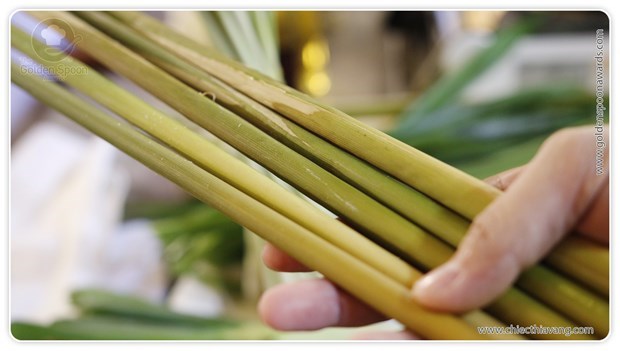
“Crac làng” plant
Just as important in
status, chefs from the Southern region also present surprising spices to the
judges such as: Galangalflower that is used to make a sauce, Custard
Apples, and Vietnamese plants like “củ xá
kiến”, “lá sọ chó”, “lá vông vang” and more. Mr Sakal Phoeung
- Chairman of Escoffier Vietnam Chef Association and Head chef of Sofitel
Saigon Plaza, one of the food experts and one member of the Judging team, all
commented immediately that the food was
“really excellent” just a quick taste of “lá sọ chó” was sufficient. “Lá
sọ chó” is a wild plant that grows up in jungle of Mountain Ba To (Quang
Ngai province). The leaves look like “cây
cần thăng” – a kind of bonsai tree. Its oil has the taste of mint but a
little more bitter. It has a pleasant subtle aroma like a weaker version of
curry leaves. It also has the slight taste and smell of dried tangerine skin or
as it is called here, “trần bì”.
Local people crush it and use it for seasoning
on various
meats before grilling. It brings very good and unique aroma. In the Golden
Spoon Contest, “lá sọ chó” deserves
to be served with lobster as the Chefs of Van Thanh Tourist area would like.
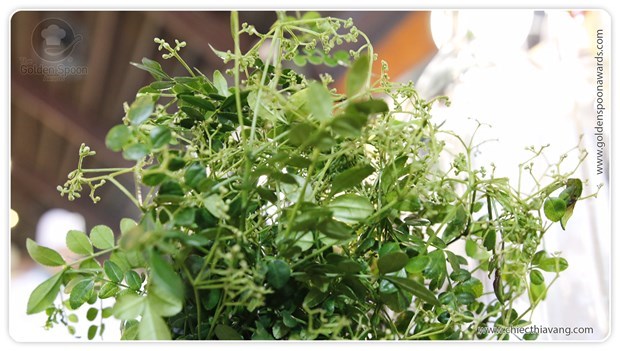
The Leaves and flower of “cây sọ chó”
For a more luxurious dish, the chefs of team No.36 (Binh
Quoi I Tourist area) take the bud of “cây
sọ chó” plant and cook it with dragon prawns to create a dish that not only
tastes better but also looks more colorful.
Talking about team No.36 we must talk about the capon
cooked with “Củ xá kiến” and served
with fresh rice noodle. This dish added one more new spice, appearing for the
first time in Golden Spoon Contest and the team absolutely nailed it. “Củ xả kiến” is a relative of turmeric,
and galangal root in both smell and taste. It has strong aroma like galangal
root but it is hot and taste a bit like mint. Chef Anh Duy said that we just
use only a small amount of this spice we can make this capon dish become a
truly outstanding one. The simple capon will crow once more.
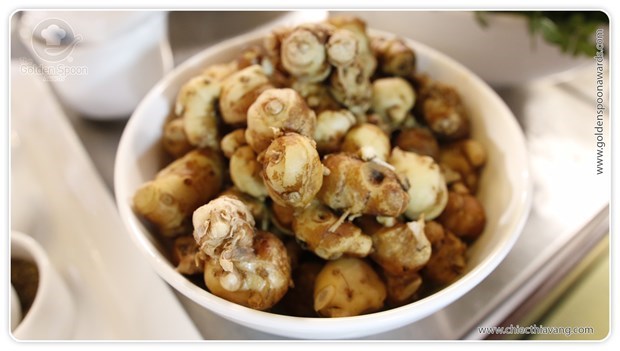
Củ xá kiến
There is a spice that comes from the Central Region but is
now found in Dong Nai province. This is of course, “Vông Vang” or “Bông Vang”.
It was introduced by Chefs from Mua Vang Restaurant. It is related to
grapefruit and has separated leaves, a green stem, with succulent and scattered
shoots. It has a light, sour flavor, suited for cooking soup. This is the
reason why sour soup cooked with “Vông
vang” and “moi” (a dried baby
shrimp) stays fresh in the memory of Chef Ha Thanh Le. A golden dish is soup
cooked with grouper fish, turmeric and “Vông
vang”.
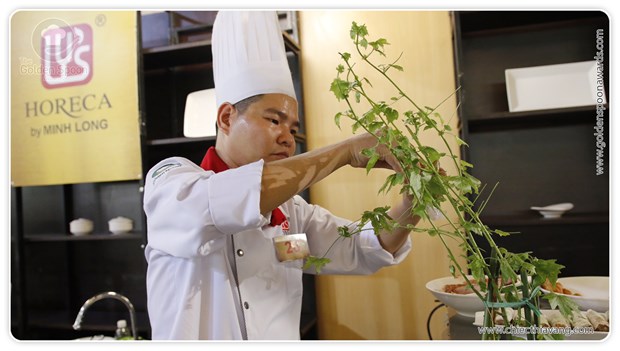
Chef Ha Thanh le used “Vông Vang” leaves to cook the soup with grouper fish and turmeric
Talking about how difficult and risky challenges we have to
mention Chef Nhu Cuong of Kim Do Hotel. He utilized spices cleverly as he
combined one specific spice into various dishes in a menu. In the previous
round, the menu was for “the party”. The subject was to use “trái giác” as a main ingredient; to
successfully prepare a menu for the “Choir” with Annona Glabra as a main
ingredient: a Annona Glabra salad with pork and shrimp, rolled cake with Annona
Glabra and Baby sour shrimp, Fresh water crab stir-fried with Annona Glabra,
Annona Glabra hot pot with “bò hóc” sauce and grilled beef with Annona Glabra sauce.
According to Chef Nhu Cuong, the challenge here is to make dishes with various
flavors but all of them come from the Annona Glabra. Therefore if it is a young
Annona Glabra it tastes like cucumber suited to a salad with it. If it is
bigger we can use it to make hot spot and if it is old then we can use it to
bake a cake. Its core could be chopped in small pieces, dried it and used as a
kind of tea.
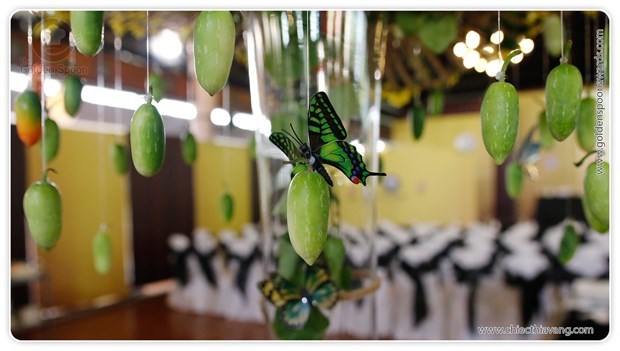
Annona Glabra
Chef Nhu Cuong also shared good news that the rolled
chicken served with sticky rice and “trái
giác” sauce was already served in restaurant and doing good business. It is
really good to hear this news, because it is hoped that all the spices that
were introduced in the Golden Spoon Contest will soon start to be enjoy by
diners as much as possible by appearing on the menus of restaurant and hotels.
To go
further with spices and delicious hometown dishes
Tri Trung